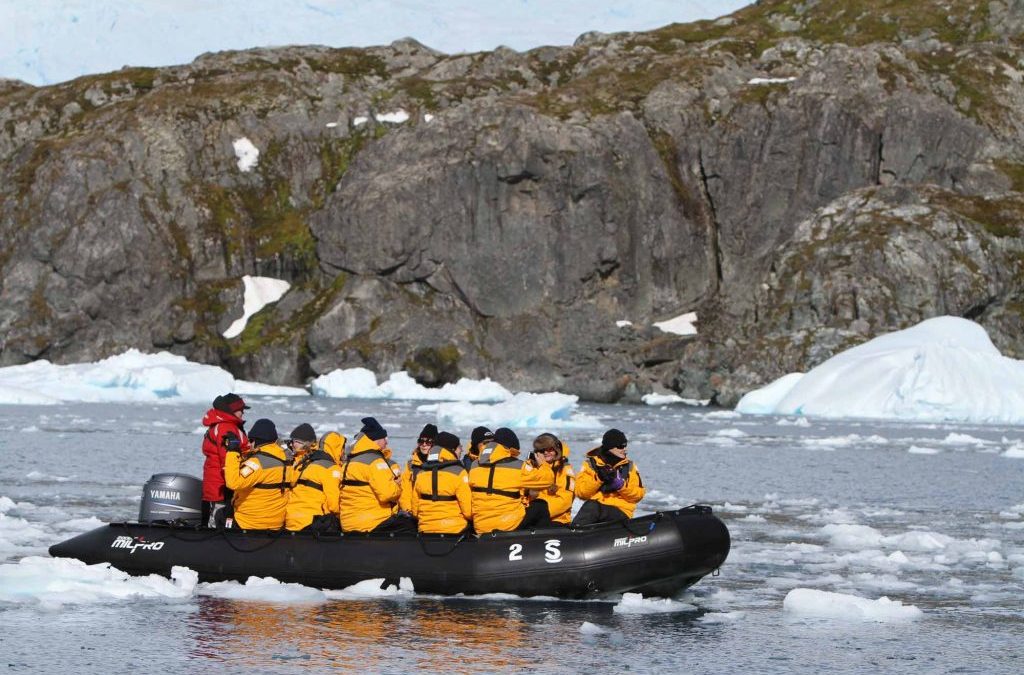
by Alex Bowles | Feb 14, 2018 | Alex, Antarctica
Antarctica was amazing! We arrived in Antarctica at King George Island on a plane painted to look like a Gentoo Penguin. We walked the two kilometers to the beach, so we could board a zodiac. The zodiac then took us to our home for the next five days, The Island Sky. When we arrived, we went to our room and had an abandon ship drill. During the drill when we were outside we saw Gentoo Penguins doing a maneuver where they swam then jump out of the water go into the water and then repeat. After that, we had dinner and went to sleep.
On the second day, we boarded a boat to take us to a small island. When we arrived, we saw an Antarctic Fur Seal swimming in the bay. On the beach, we could see an old boat used in whaling time with whale bones around it, with 4 Gentoo Penguins inside. From there we hike up a ridge to look at Antarctic Fur Seals. When we got closer we saw more Gentoo’s on a rock, that had many fur seals surrounding them. Then on the beach, we saw two Weddell seals. They were about ten feet long and the entire time I watched them I could only see them scratch their stomach with their flippers. After that, we hiked back up the ridge and down the other side. From there we could see Kelp gulls flying around with massive Brown Skua’s. Then on the beach, we saw a Southern Elephant seal flop it’s way to the water’s edge and then stop. Near a red shack, we saw hundreds of Gentoo penguins waddling around and I smelled my first smell in Antarctica, guano. After an hour we went to the zodiac and headed back to the Island Sky. On the way back, in the distance, we saw a Humpback whale.

For the second excursion of the day, we did a cruise on a zodiac through an ice flow. The small pieces of ice came from when the nearby glacier calved or when the icebergs melted, and a chunk fell off. When we started we went into the ice floe and it felt like driving on a bumpy and slippery road at the same time with the sound of crushing ice. After we made it into the ice floe we came upon a small flat iceberg with a leopard seal lying down on its side. We watched it for a few minutes then went to another area of the floe and saw another leopard seals. We watched that one for a few minutes the went to see another part of the floe and guess what? We saw another leopard seal with a crabeater seal. The crabeater seal doesn’t eat crabs but instead eats krill. Our guide told us that she has never seen three leopard seals in half an hour. What happened next didn’t surprise us. We went to another area and saw another leopard seal that entered the water shortly. At the days’ recap, we were told that we saw every type of seal in Antarctica except one, the Ross seal, that is very rare.

The next morning when my mom was looking out her window she saw a hump come out of the water. I came over to investigate and it turned out that those humps were the fins of two Antarctic Minke Whales. After that, we boarded a zodiac to go to mainland Antarctica. On the way, we saw a glacier calve and it wasn’t small. The guides who come here often said that it was a big calve. We then hike up a big ridge and, on the way, up we saw some Gentoo’s molting, growing new feathers, with a lone Chinstrap Penguin in the group. After that, I hiked the rest of the way up and spent most of the time on mainland Antarctica watching the glacier calve. We then went back to the Island Sky to prepare ourselves for the polar plunge. After my Dad and I changed into our swimming suits we walked outside onto the deck and stood in the line. The anxiety was killing me. I watched as person after person jumped into the water and came up saying it was cold. By the time it was my turn to jump I was shaking. I then accumulated just enough courage to jump into the water. The water was two degrees Celsius and was not enjoyable. It was so cold I pulled my self out of the water as soon as I could. As soon as I got out of the water I could tell that the air was warmer than the water.
We had lunch with probably the coolest person I know personally, Ed Webster. Ed was born in Boston but was raised in Lexington. When he was eleven his mom saw him climbing trees in the backyard. She went to the library and borrowed a book to teach him how to climb. He is a climber that has done many first ascends in Utah and around the world, including a new route up Mt. Everest’s dangerous East Face.
During lunch, we were informed that there were orcas near the boat. Even though it was still lunch I ran outside to see the orcas. Upon closer inspection on the orcas, they turned out to be Class B large. These are the type of orcas that make a wave to push seals off ice floes.
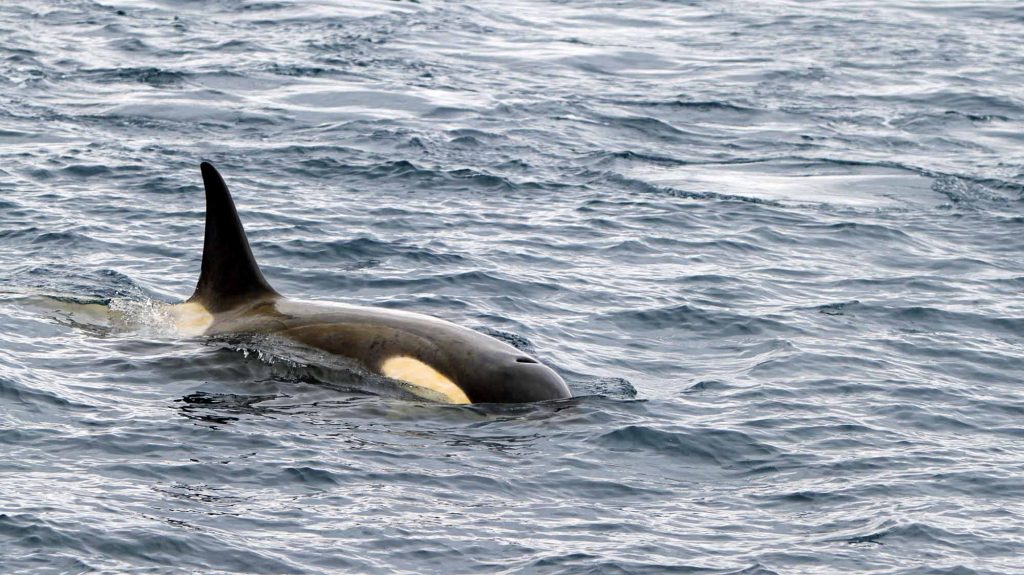 For the second excursion on the second day, we went to the largest colony of Gentoo Penguins in the region. We got there and saw thousands of penguins. My dad didn’t do the excursion with us because he went stand up paddleboarding. On the beach, we walked to the right and saw that the penguin colony extended 30 meters up the hill. You could easily see where the penguins would “commute to work” each day. You would see a pile of snow about a foot deep but where the penguins walked there was snow. After watching penguins got down to the ocean I watched one swim. They look like they are flying underwater, flapping their wings to propel them forward. On the way back to the boat our guide spotted two humpback whales near the paddle boarders. We went over there, saw the humpbacks a couple more times before one of them it fluked, and it was gone. On the way back to the boat we saw a leopard seal on a rock and I spotted two humpback whales. We went over there and watched them for a few minutes before they too left. On the way back, we saw another leopard seal. That night Ed gave the lecture “Everest, the really had way.”
For the second excursion on the second day, we went to the largest colony of Gentoo Penguins in the region. We got there and saw thousands of penguins. My dad didn’t do the excursion with us because he went stand up paddleboarding. On the beach, we walked to the right and saw that the penguin colony extended 30 meters up the hill. You could easily see where the penguins would “commute to work” each day. You would see a pile of snow about a foot deep but where the penguins walked there was snow. After watching penguins got down to the ocean I watched one swim. They look like they are flying underwater, flapping their wings to propel them forward. On the way back to the boat our guide spotted two humpback whales near the paddle boarders. We went over there, saw the humpbacks a couple more times before one of them it fluked, and it was gone. On the way back to the boat we saw a leopard seal on a rock and I spotted two humpback whales. We went over there and watched them for a few minutes before they too left. On the way back, we saw another leopard seal. That night Ed gave the lecture “Everest, the really had way.”
The third day, we went to Deception Island. Deception Island is an active volcano that has erupted three notable times in the past 50 years. When we arrived, we saw very few Gentoo Penguins and many Antarctic Fur Seals. We were in Whalers cove where there was an old whaling company. We walked near the ruins of old whaling time boilers that would cook the whale, a penguin guano oven, and an old hanger. Until 2001, a twin otter (the type of plane normally used in Antarctica) was inside the hanger. The British caught wind of an American collector that was going to buy the plane from the Argentine’s. The British then quickly took the plane to a museum in London. On the way back to the Zodiac, we went to the graveyard for people that died on Deception Island. There were 32 graves, but the most recent eruption melted the ice and created a landslide that took most of the graves away. There are now only two graves and only one of them has a name. When we made it to the boat, we stuck our fingers in the sand at the waters’ edge. The sand felt warm, and if you put your finger in an inch, it would burn. It was warm due to the same volcanic activity that made the warm gas come out from the ground. After that, we went back to the Island Sky.
For our final landing, we went to a Gentoo and Chinstrap penguin colony. When we arrived, we saw a couple cow elephant seals laying down. We then walked a little way up and saw two chinstrap penguins. We then walked up a small ridge and saw hundreds of dirty, small Chinstrap penguins chicks. It surprised me to see these many penguins choosing to stand in the mud and not the grass ten feet away. On our right, we saw Gentoo penguins with Snowy Sheatbills. We walked through a very muddy area to get to the path to go to the other beach. We got to the flat area of the path and saw that there were hundreds of penguins in the way of the path. So, we stopped there and watched the penguins in the small area we could wander in. The area progressively got smaller because the penguins would grab the poles that signify our boundaries and move them closer to us. Luckily the penguins weren’t very fast. I then looked at the pile of blubber that turned out to be many cow elephant seals. There was one penguin that tried to open the bag our guide had, but he was unsuccessful, so he decided to lay on the bag. After a couple minutes of watching the penguin on the bag, I turned back to the boat to go to the other beach.
When we arrived at the second beach, we saw a few Gentoo penguins. We then walked over to Ed who was talking about the fossils found in the area. He showed us some petrified wood and fossilized ferns that proved that Antarctica was once tropical. We then walked down the beach as Southern Giant Petrels, each one with a wingspan of seven feet, soared high above us. We then walked as far as we could on the beach and saw more Elephant seals. We walked behind a rock to see what people were looking at and saw a few cow elephant seals with a bull elephant seal. All of them were massive. We stared at them for a minute before we looked at the other elephant seals. In the group, there were a couple smaller females and a gigantic bull elephant seal. He was at least 18 feet long and probably weighed over 1100 pounds! The seals just laid there most of the time. Eventually, one of the females flopped her way closer to the sea. We saw more Gentoo penguins and two fur seals. We decided it was time to turn in and go back to the ship. This was our last excursion in Antarctica.
When we made it back to King George Island, we got off and saw two Gentoo and two Chinstrap penguins standing on the beach, biding us farewell. I wanted to see penguins and I wasn’t disappointed; I saw at least one Gentoo penguin every day. We then walked the two kilometers to the runway. We then waited a couple minutes for our plane, standing right near the runway that our penguin plane landed on. We then walked on the runway, talked to Ed, and then boarded the plane. Ed waved goodbye to me and I waved back. When I entered the plane, my eyes were watering up. I couldn’t tell if it was because I was leaving Antarctica, my favorite place to travel to, or I was staring into the cold, dry winds for too long.

by Alex Bowles | Feb 7, 2018 | Alex, South America
Argentina is a jolly good spot for seeing, and drinking from, glaciers. While we stayed in El Chalten we hiked on the first day to a lookout of Cerro Fitz Roy. The second day we hiked to where the Grand Glacier and Torre Glacier came together to form Laguna Torre. In Laguna Torre,
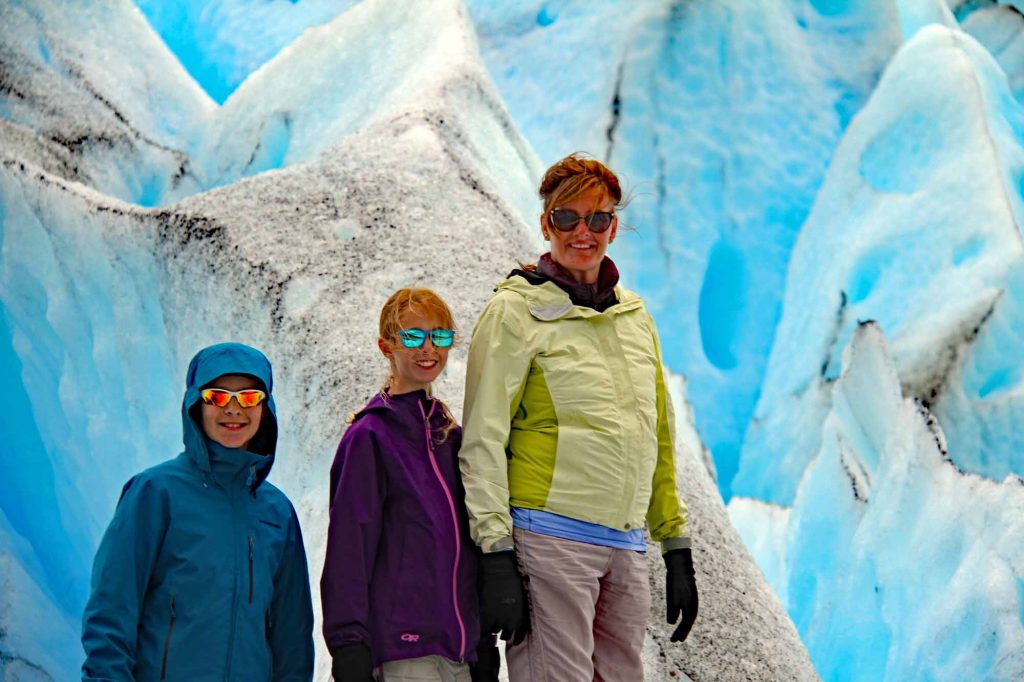
Trekking on the Perito Moreno Glacier.
we saw many icebergs in the lake and we put some of the ice chunks in our water. On the way back, we saw six Andean Condors, two of which were fighting. When we were in El Calafate, we hiked to, and on the Perito Moreno Glacier. While we were on the glacier, Maile and I would constantly take chunks of ice from the glacier and drink them. The following day we boarded a bus to Puerto Natales. From there we boarded a bus to Punta Arenas. The bus rides took a total of 13 hours.

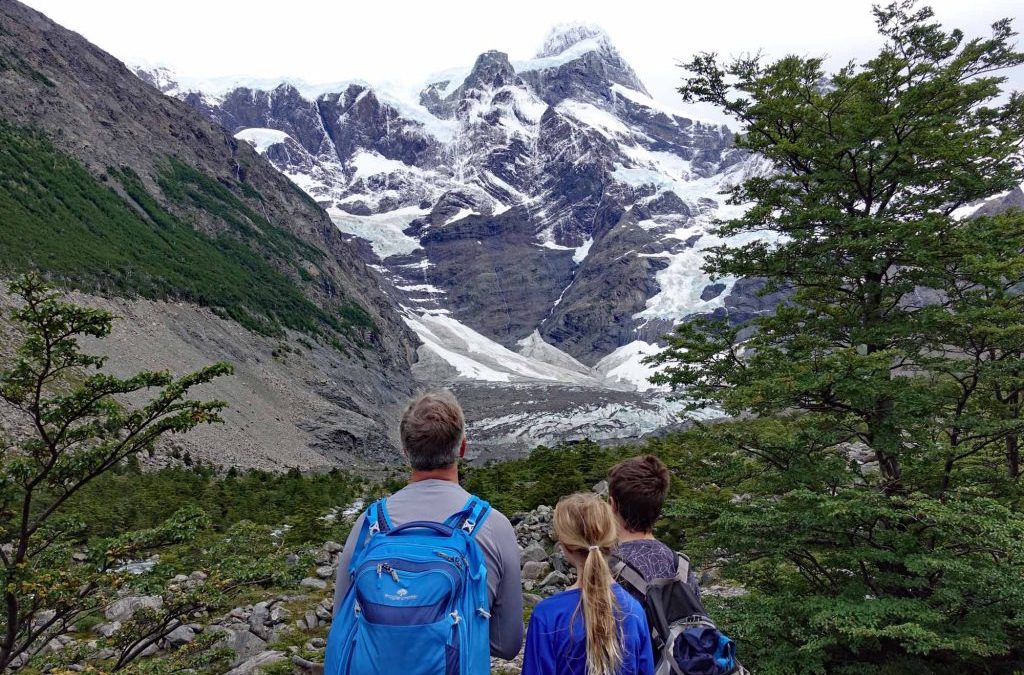
by Alex Bowles | Feb 4, 2018 | Alex, South America
Today we went to Torres Del Paine, located in Southern Chile or otherwise known as Patagonia. Torres Del Paine is in a local language and translates to Towers of Blue. On the way to the Parque national we saw many guanacos, they are related to llamas, but the difference is all llamas are domesticated and guanacos are wild. Many of the guanacos would stop eating, raise their long necks and look at us which made me feel a bit sad and hungry. They are interesting animals with their long necks, soft fur and the ability to use spit as a defense, but they are so delicious. We were told inside the Parque National the population of pumas, called mountain lions and cougars in the United States, has boomed and that we had a good chance of seeing them and a couple weeks before we arrived, one was seen around our hotel.
When we arrived at our hotel, Ecocamp, we were led to our dome. It had a loft with two beds and two beds pushed together on the lower floor. We were told not to open all our stuff because we would leave tomorrow morning to go to the Refugio Paine Grande. To get to the Refugio we had to take a van to the dock, ride a short boat ride, pequino when compared to the Navimag ferry. When we arrived at the Refugio we dropped our bags and headed off to hike the French valley. Before we could reach the French valley, we had to hike 10 kilometers to get to the Italian camp then start the trek up the French Valley. On the way to the Italian camp, we passed through a forest, of burnt trees. Our guide, Mariana, told us the fire was started in December of 2011 when a guy, camping in an area he wasn’t supposed to camp in, decided to burn toilet paper. The small fire he made was blow out of control when the 90 kilometers per hour gust spread the fire to the Lenge trees and burned 18,000 hectares. When we made it to the Italian camp, we started the medium difficulty hike up to the French glacier. To get to the lookout we had to hike up the moraine of the glacier, the area where rocks were discarded as the glacier retreated. It was a little difficult to climb but the view was worth it. From the lookout, we could look down the valley and see the greyish blue lakes, gray from the sediments as the glaciers melted. Then, when we were standing and admiring the hanging glacier we hear a crack and watched as a chunk of ice fell off the numerous cliffs. As it rumbled down the cliffs it gathered snow and speed. When it reached the final cliff, it fell about 70 meters and lasted a few minutes. On the way back to the Refugio, we had a constant wind of 50 kilometers per hour and gusts of 90 kilometers per hour which scarred Maile enough to not go outside at the Refugio except when needed. At dinner, Maile begged my Dad not to do the next day’s hike because she was afraid she would blow away.
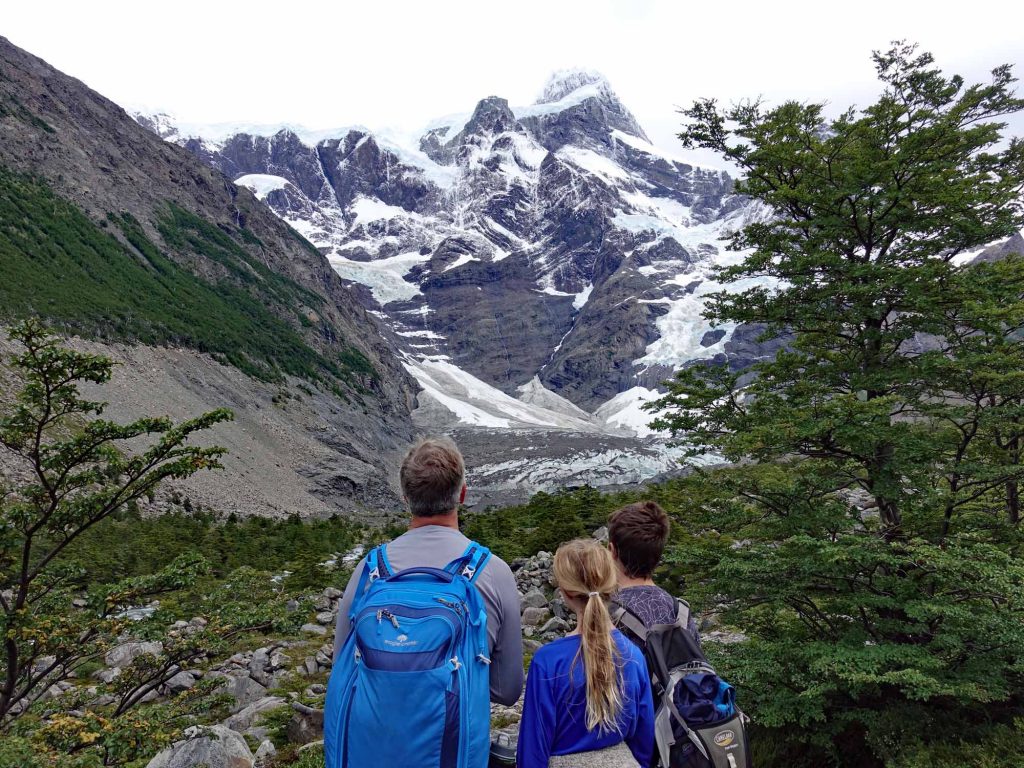
View of the French Valley Glacier
The next day my Dad and I hiked the trail to Glacier Grey. Maile, because she was terrified by the concept of wind as strong as yesterday, wimped out of the hike. The hike to the lookout was uneventful. There were gray clouds that followed us all day. When we made it to the lookout we saw Glacier Grey and some icebergs in Lago Grey. At the lookout we were given a choice, hike eight more kilometers to the shore and hope that the boat is not canceled; if the ferry was canceled we would have to run 16 kilometers to get the 6:30 ferry at the Refugio or turn back now and get the 1:30 ferry. We decided to catch the 1:30 ferry and not test our luck because yesterdays ferry was canceled due to wind and today was supposed to have the same weather. We got to the Refugio an hour earlier than the boat left and relaxed. We boarded the ferry, rode to the other side, saw some waterfalls and learned that the boat did run on time.

Grey Glacier
The final day we were going to do the base of the towers hike. We started early, just like every other morning, and started the trail. Before we could get to the actual trail we had to walk two kilometers on the dirt road then cross a bridge to the other side. We waited in line and watched ten people cross at a time, and as we got closer to the bridge we noticed a sign. The sign read, “Two people at a time please.” After that, we started the ascent of the trail. When we made it to a big tree growing in the middle of the path my Mom decided to turn around. She hurt her leg going down the French valley and didn’t want to hurt herself again. Maile didn’t want Mom to leave, and so she had a meltdown. It took about thirty minutes for her to calm down; the only thing that motivated her to continue was the prospect of getting a life-sized emperor penguin plush. The trail only got steeper and more hazardous from there. We decided to take the horse trail because it was cleared of debris and the dirt was packed down. After we rounded the windy pass we descended into the valley and into the Chileno camp. From there we continued to hike up the valley and across bridges until we reached the moraine of the glacier. This moraine was the hardest thing I have climbed in my life! There were huge rocks in the trail you had to go over. On the way up, we saw a team of people pulling and pushing this form of a wheelchair so that a disabled woman could see the towers. When we finally made it to the top the first thing that caught my eye was not the towers, but the numerous waterfalls that fell hundreds of meters from the hanging glaciers to a lake below. Our feet hurt so much when we reached the lookout we called the hike “Towers of Pain”. We ate lunch at the base of the Towers and took some pictures of the glacier-fed waterfalls with the towers in the background. Then we saw a crazy person take off his shirt, grab a bottle of wine, walk into the water and swim in the freezing cold water. Just for a picture. Then we saw another person do the same thing. After that, we walked down and made it back to the domes at Ecocamp to relax.


by Alex Bowles | Jan 29, 2018 | Alex, South America
Day 1
 Boarding the ferry.
Boarding the ferry.
We just boarded the cargo ferry, Eden, in Puerto Montt, Chile; the boat is bigger than I imagined. Maile has been extremely excited for the ferry ride, saying it is the part she is most looking forward to. She is even more excited about the ferry journey than seeing penguins in Antarctica! Maile and I are a little bummed because we were just informed we would not have bunk-beds but instead, two rooms. Before we could explore the ship, we had to climb four flights of ladder-like stairs, each of us carrying 30 pounds of luggage. After dinner, the realization of what this journey will be like has finally sunk in–no Wi-Fi!
Day 2
We woke up to cloudy skies and had breakfast. The sky outside was cloudy and rained for most of the day. The breakfast was small and not like any other meal on the boat. Maybe they were giving us less food, so the fish would get fed less. After lunch, we left the safety of the fjords and headed out to sea. At first, I thought it was fun, the continuous movement of the waves rocking the ship back and forth. Then my stomach started to twist and turn. I couldn’t imagine what I would have felt like had I not taken a Dramamine pill. For the next several hours, I barely left the safety of my bed. In the time I was in my bed I came to the realization that we were in a prison. A prison continuously moving up and down, swaying side to side, at the mercy of the cruel ocean.
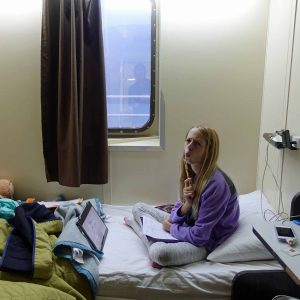
Day 3
We woke up to the sound of the overhead announcements declaring that breakfast was ready. We were on still water and had great views of the Andes mountains with waterfalls fed by the snowmelt, even though it is Summer down here. The waterfalls created an even more elegant view of the breath-taking mountains, with the snow-capped peaks against the cloudy skies. Oh, what a beautiful morning. During the lecture on the uniquely adapted plants of the region, we saw a pod of dolphins playfully jumping in the wake of the boat. After three days on the boat, I have realized that boat life is not very active. Most of the time it was raining, like right now, but when it is not raining there is a strong wind. Most of the time we spent inside sitting down. The things to do were very limited, as the boat was made for commercial purposes, like transporting cows and salmon food, not for transporting people in a luxurious way. There was a naturalist on board who gave informative lectures every day. During the lecture on Torres Del Paine, we were blessed with the presence of ten to fifteen penguins standing on a rock, watching us.
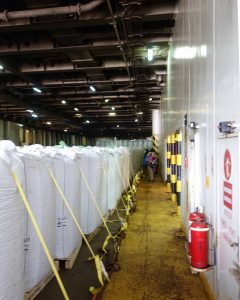 Huge bags of salmon food. There are a lot of salmon farms in southern Chile.
Huge bags of salmon food. There are a lot of salmon farms in southern Chile.
Day 4
Today we finally made it ashore. Before we could dock the crew had to pass a very large rope—probably 6 inches in diameter—to the dock workers. It was very windy and they didn’t catch the rope, so we had to power away from the dock and circle around the bay to try again so the wind wouldn’t crash us against the dock. Luckily, on the second try, we made it with no harm done to the boat. The pier, on the other hand, did not fare so well. It had a giant tire to stop the boat from hitting the concrete that got caught in the rope and when the rope pulled tight it jerked the tire off of the pier and it sank. Terra firma has never felt so good.
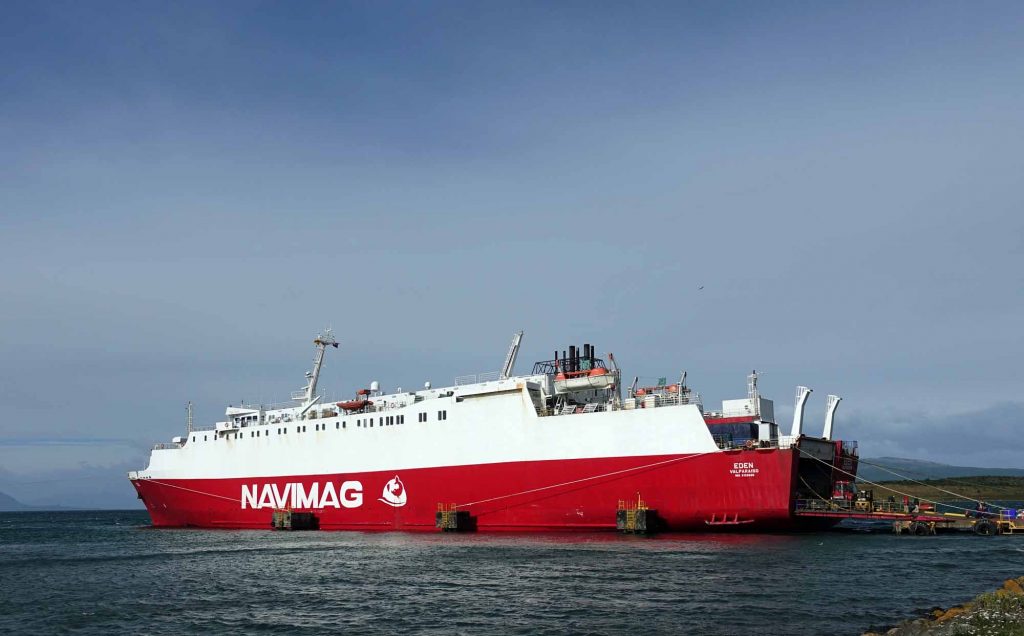
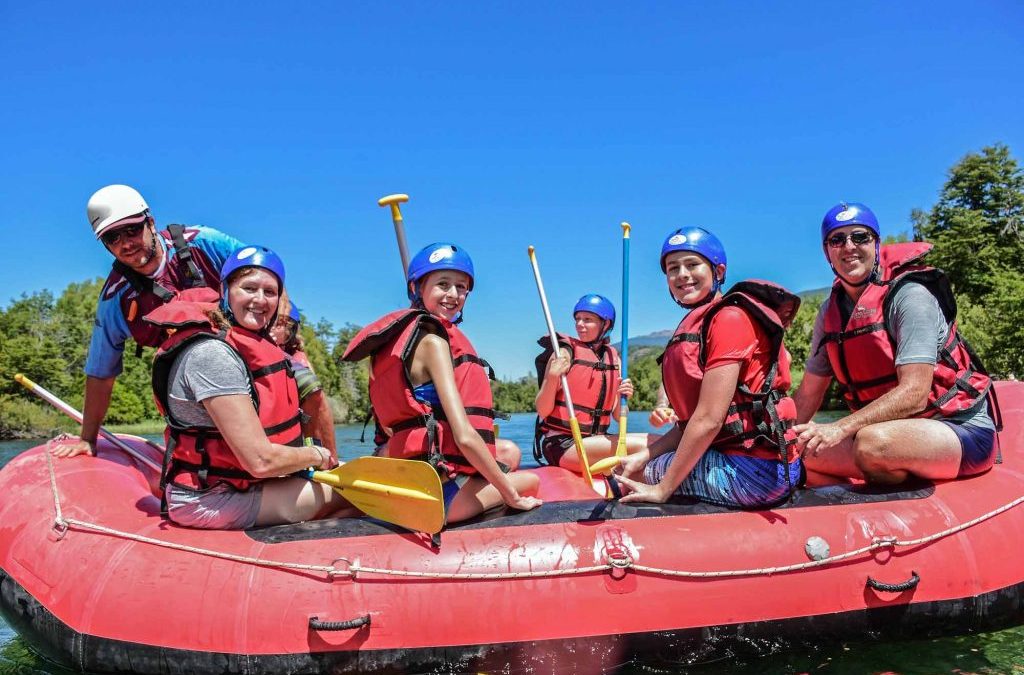
by Alex Bowles | Jan 22, 2018 | Alex, South America
Today we went on a white water raft tour down the Manso river in Argentina. I always wanted to raft down a river with rapids and, as Master Yoda said, “Do, or do not, there is no try”. To get to the river we had to travel across the continental divide; every river to the west of the line flows to the Pacific and those to the east flow to the Atlantic. When we arrived at Stephan lake, where the river started, we found the water to be crystal clear and our guide said that this water was drinkable so I drank straight from the river.
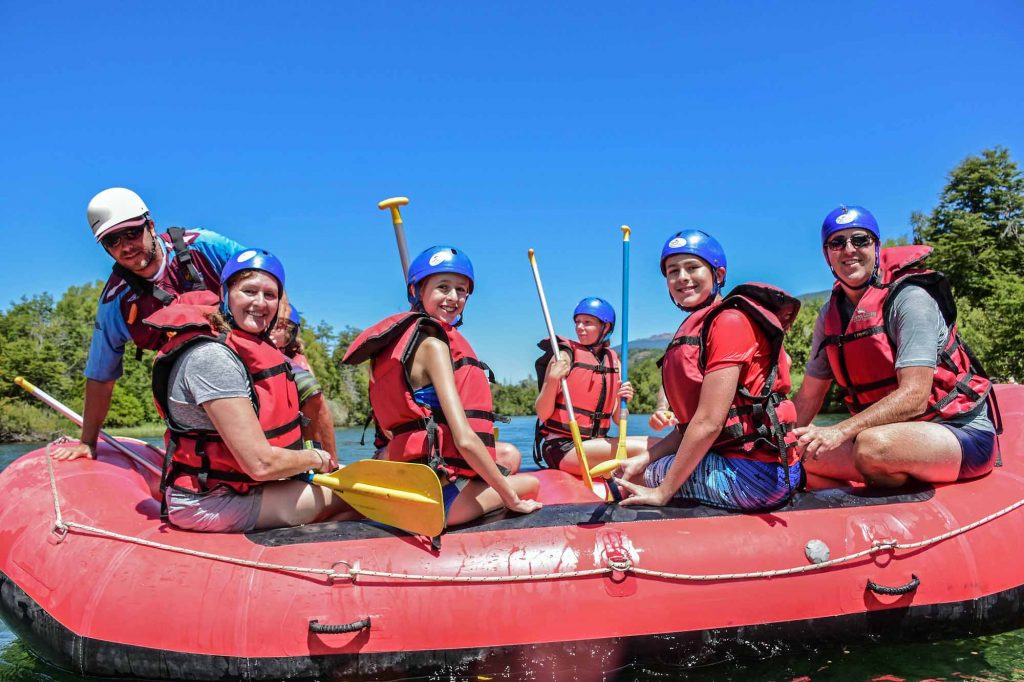
Rafting the Rio Manso.
When we started, we were on a calm lake that was perfect for swimming. The water was cold, not surprising because you could see patches of snow on the mountain peaks above us. In the beginning, there were little rapids but nothing I wouldn’t swim through. Maile almost from the get-go didn’t want to do it so she sat inside the boat and did virtually nothing for the next couple hours. Then, after an hour, we made it to the first rapids. These were only Class II rapids. They felt like driving down a bumpy road with a garden hose spraying you. Before we were near the rapid our guide instructed us how to make it through the rapid without flipping our raft. We had to paddle fast and furiously to negotiate the gauntlet of boulders. When we went over the only Class III rapid it felt like falling three feet in a car, entertaining but unnerving. After we successfully made it through the Class III rapid we did many ludicrous things under our guide Marco’s instructions. We ran class II rapids backward, spinning like a helicopter rotor, and standing up. When we were nearing the end the current slammed our raft into a rock and created a huge wave that soaked my mom and I. Then we had smooth sailing until the end of the tour.
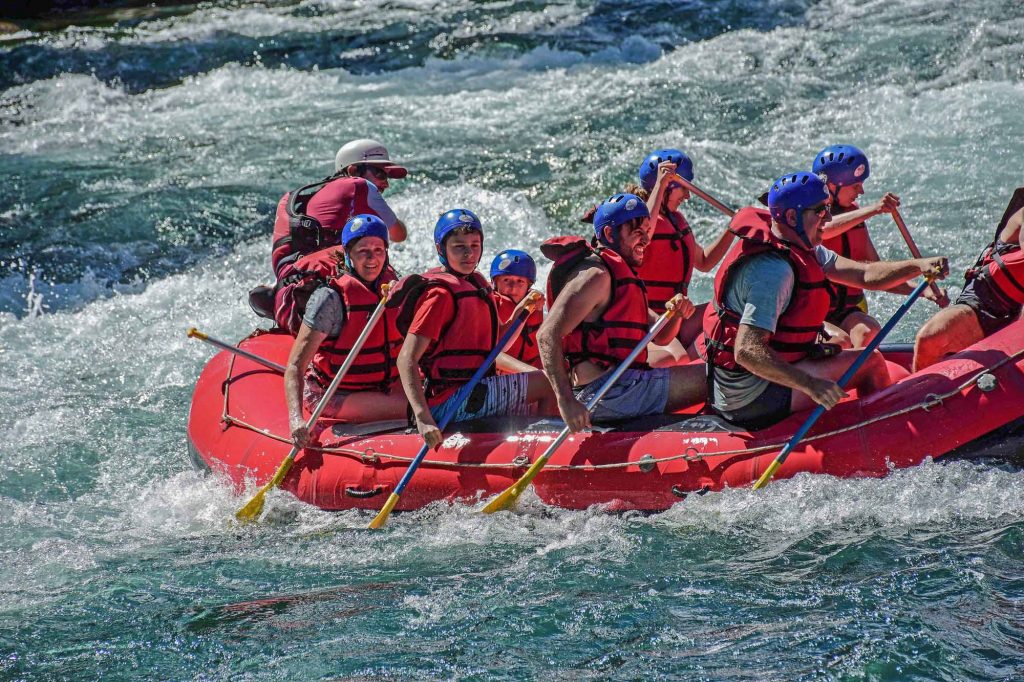
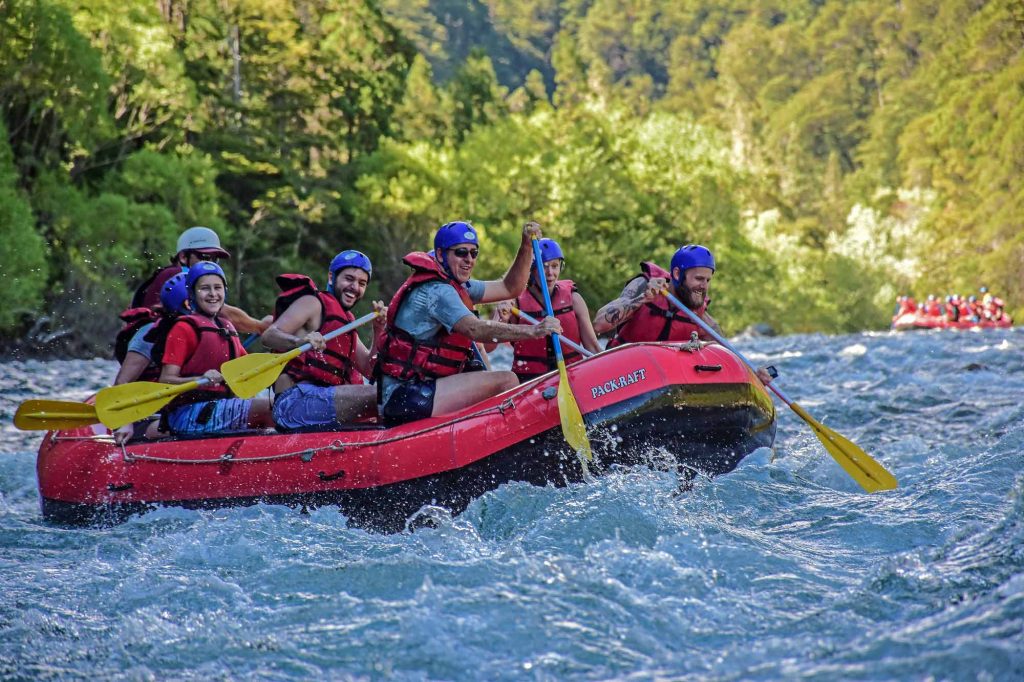




 For the second excursion on the second day, we went to the largest colony of Gentoo Penguins in the region. We got there and saw thousands of penguins. My dad didn’t do the excursion with us because he went stand up paddleboarding. On the beach, we walked to the right and saw that the penguin colony extended 30 meters up the hill. You could easily see where the penguins would “commute to work” each day. You would see a pile of snow about a foot deep but where the penguins walked there was snow. After watching penguins got down to the ocean I watched one swim. They look like they are flying underwater, flapping their wings to propel them forward. On the way back to the boat our guide spotted two humpback whales near the paddle boarders. We went over there, saw the humpbacks a couple more times before one of them it fluked, and it was gone. On the way back to the boat we saw a leopard seal on a rock and I spotted two humpback whales. We went over there and watched them for a few minutes before they too left. On the way back, we saw another leopard seal. That night Ed gave the lecture “Everest, the really had way.”
For the second excursion on the second day, we went to the largest colony of Gentoo Penguins in the region. We got there and saw thousands of penguins. My dad didn’t do the excursion with us because he went stand up paddleboarding. On the beach, we walked to the right and saw that the penguin colony extended 30 meters up the hill. You could easily see where the penguins would “commute to work” each day. You would see a pile of snow about a foot deep but where the penguins walked there was snow. After watching penguins got down to the ocean I watched one swim. They look like they are flying underwater, flapping their wings to propel them forward. On the way back to the boat our guide spotted two humpback whales near the paddle boarders. We went over there, saw the humpbacks a couple more times before one of them it fluked, and it was gone. On the way back to the boat we saw a leopard seal on a rock and I spotted two humpback whales. We went over there and watched them for a few minutes before they too left. On the way back, we saw another leopard seal. That night Ed gave the lecture “Everest, the really had way.”








 Boarding the ferry.
Boarding the ferry.
 Huge bags of salmon food. There are a lot of salmon farms in southern Chile.
Huge bags of salmon food. There are a lot of salmon farms in southern Chile.




